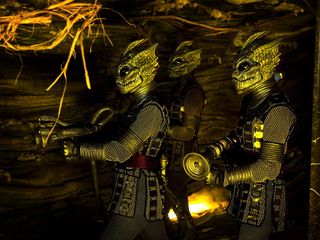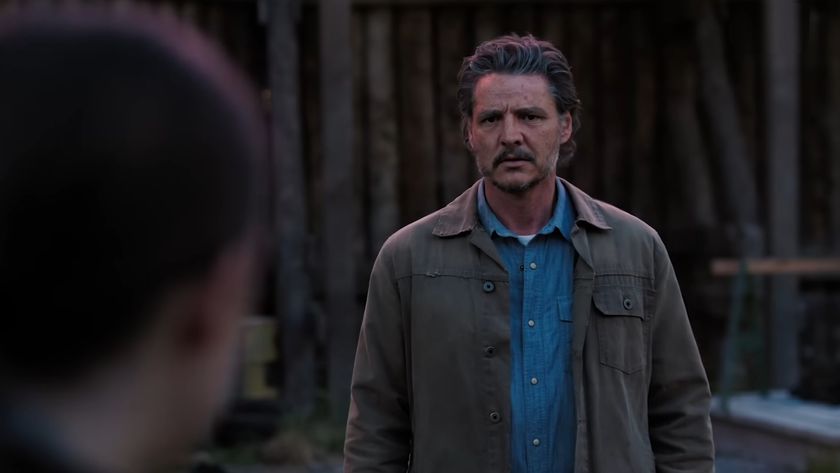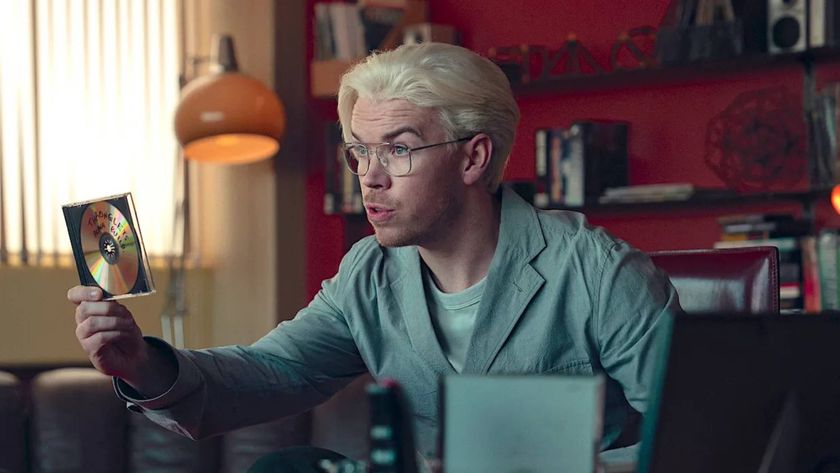Doctor Who Cold Blood Interview
None
Chris Chibnall tells SFX about his Silurian two-parter...

Amy’s been captured by the Silurians, the Doctor and new sidekick Nasreen have just tracked down a giant underground city, and Rory and his two companions are keeping an eye on a reptilian prisoner with a vicious tongue. With the Silurian two-parter concluding this Saturday with “Cold Blood”, we speak to writer (and former Torchwood boss) Chris Chibnall about returning to the Who -niverse, resurrecting homo reptilia and the Sea Devils – in a considerate, spoiler-free way.
It’s been a couple of years since you finished on Torchwood . How was it coming back to the Doctor Who universe?
It was great and it was unexpected –I thought I’d done a lot of Torchwood and a Doctor Who and moved onto other things, so when Steven [Moffat] emailed it was very out of the blue. He just emailed saying, “the Doctor needs you!” one Saturday morning.
So was bringing the Silurians back your idea or his?
Piers [Wenger, executive producer] said we’ve got one word to say to you, come and meet us next week. I was thinking, what on Earth is that word? Then they said “Silurians” – and that it was a two-parter. That was kind of it, really – Steven said, “I want Silurians and I want a big drill, off you go.”
Was that the extent of your brief?
Yeah, pretty much, so I went back and read the original novel, Doctor Who And The Cave Monsters , and watched the original story, and tried to get a sense of what [writer] Malcolm Hulke had envisioned for it, not just on screen but also when he had the complete freedom with the novel – where he took the Silurians, how much more developed they were, how much more characterised they were than had been possible on screen. First of all I said we have to have a big city, and from then it was very much that I wanted a tiny community on the surface against a huge Silurian city underneath the Earth.
Sign up to the SFX Newsletter
Get sneak previews, exclusive competitions and details of special events each month!
It’s over 25 years since the Silurians last appeared on TV. Does that mean you have to write assuming none of the audience has seen them before?
It’s not like with the Daleks and Cybermen where you can perhaps assume that there is a certain degree of knowledge or awareness among the general viewership. We start from the basic position of knowing nothing about them, and then introduce them in the most exciting and scary way possible for people who’ve never seen them before. It’s such a small percentage of your viewers who’ll know the Silurians that you really have to be thinking for the mainstream audience, and hopefully there’s enough to keep the old fans going. The whole brief from Steven was to bring them to a whole new audience, so you have to write for the new audience, but equally I’ve seen that story, I love that story, I love those creatures, so you have to find a balance while telling it for a seven o’clock audience on a Saturday night on BBC One.
Until we saw the Silurian city, the first part of the story was quite small scale. Will it get bigger in the second half?
The second half is totally different to the first half. We always talked about that as a big split between the two episodes, that you’d start with quite a small canvas and then you would broaden and broaden and broaden, so as the characters in the stories realise how much more there is, you’re going on that journey with them as a viewer. In part two you’ll see a lot of the Silurian city, you’ll see more Silurian characters, you’ll see more warriors. A lot of that second episode takes place underground.
So will we get to see dinosaurs?
No, you’re not going to see dinosaurs, but you are going to see a lot of Silurians.
The Silurians are rather different to their counterparts in the original series. Did you have the new-look creatures in mind when you were writing, or were you thinking about their predecessors?
I was writing for re-envisioned Silurians, because Steven’s brief was to make them for now. For a start Steven had said, “I don’t think we want the third eye – Davros has a third eye and these have to be completely different.” His brief was that this is a different branch of the same species – the original Silurians are still there and this doesn’t undermine them.
In the script I’d said they had to be beautiful - we talked about that right from early on so you could really see the actors underneath the prosthetics and the actors would have the ability to give really strong and different performances. You’ll see in “In Cold Blood” that they’re as individual as the humans, because the whole thing is about both the differences and the similarities between two different races who’ve occupied planet Earth.
They’ve got a poisonous tongue now…
You can’t just take things away, you have to add things in. I wanted something that you could do in the playground if you’re nine years old, so I think the venom and the sting were important. Also, in the next episode you’ll see more of their weapons which have a bit of a nod to the old Sea Devil heat rays.
Were the warrior masks a clever way to avoid making complex prosthetics for all the Silurians?
The moment we saw the mask was a fabulous moment, because it was a really great solution to that problem. You can only afford so many prosthetics, and normally on Doctor Who you’ve got those slightly cloned monsters like the Ood who are very uniform , and you can get a lot of numbers because they’re just masks you pull over your face. The thing about Silurians is that what makes them brilliant is also what makes them incredibly expensive, which is the prosthetic procedure which is individually designed to each actor and individually applied. The face mask was a solution to that, and when the design came out from Millennium FX we all fell in love with it. I thought it was terrific and gave it a great new image, and was entirely credible as a warrior mask, so I was really thrilled with what they did with that, and with the prosthetics generally. I really think that they’re beautiful, and when you think they’re in HD now it really is an amazing achievement.
The Silurian soldier on Earth gives the impression she can predict the future. Have you given them the power of prophecy?
No, I don’t think there’s a power of prophecy, but I think there’s a sense – and there’s a little bit more of this with other Silurian characters in part two – that they’ve been keeping an eye on the humans while they’ve been sleeping, that they’ve been profiling them and keeping records. What she’s doing there is much more, I think, psychological warfare. She’s very much goading those characters. It’s about a zealot who is trying to use the power of psychology to destabilise the other three, so it’s as much about mindgames as anything else. It’s not prophecy, but that’s not to say she won’t be right!
Unlike most Doctor Who foes, the Silurians aren’t aliens invading Earth – they’re an indigenous population. Does that make them an interesting species to write?
I think that’s the whole joy of them, really, and you have to sort of honour that and play that through. In “Cold Blood” it’s about a) where does the doctor side, and b) how do you resolve the situation. I think what was exciting for me was the fact that the Silurians and humans want the same thing and are going to come to conflict over it, and it also puts the doctor in a great position because he understands both points of view.
Amy’s not in “The Hungry Earth” much. Was that a dramatic decision or a production-based “let’s give Karen Gillan a rest” decision?
If anybody was going to be sucked under the Earth, it kind of had to be Amy, and I do like it when the Doctor and the companion are split up. But you’ll see she’s very, very, very important in the second episode. Also, Steven had said we’d come the middle of the series so it’s nice to see this Doctor with other people, so Nasreen [the Meera Syal character] becomes a kind of de facto companion for a little bit, and you can see the Doctor behaving in a different way. So it was a creative choice really – she’s very important in the second half of the story.
Were you tempted to bring back the Sea Devils as well?
We did have conversations about it, but I think you have to tell the story you’re telling. I think the story is so clearly about the Silurians and what the Silurians want that it’s nice to have a real kind of singularity of purpose to the story. You want to do one race of monsters as well as you can, and you want to spend your money on that. To do two would be much tougher – you’d have to have two leaders, for example.
But I’d love to see the Sea Devils come back. I did say, “Should we put them in, should they be kind of swimming in those pools of lava under the Earth?” but we decided to just do the Silurians. You have to be quite rigorous with yourself as a fan of the show, because it’s like having a sweet tooth – you just want to bring all of these things back and you have to think, hang on, what does the story need? And the story needs that resonance between homo sapien and homo reptilia, and I think if you bring the Sea Devils in that confuses that really clear bit of mirroring. But they should come back. The campaign starts now!
"Cold Blood", the second half of the Silurian two-parter, airs on BBC One at 7pm this Saturday.
Richard is a freelancer journalist and editor, and was once a physicist. Rich is the former editor of SFX Magazine, but has since gone freelance, writing for websites and publications including 12DOVE, SFX, Total Film, and more. He also co-hosts the podcast, Robby the Robot's Waiting, which is focused on sci-fi and fantasy.

The Last of Us showrunner says "flat out" that "I am not going to go past the game" like Game of Thrones did with George R.R. Martin's novels

New Black Mirror season 7 trailer reveals how Will Poulter's Bandersnatch character returns to the Netflix show - with a Sonic the Hedgehog namedrop











